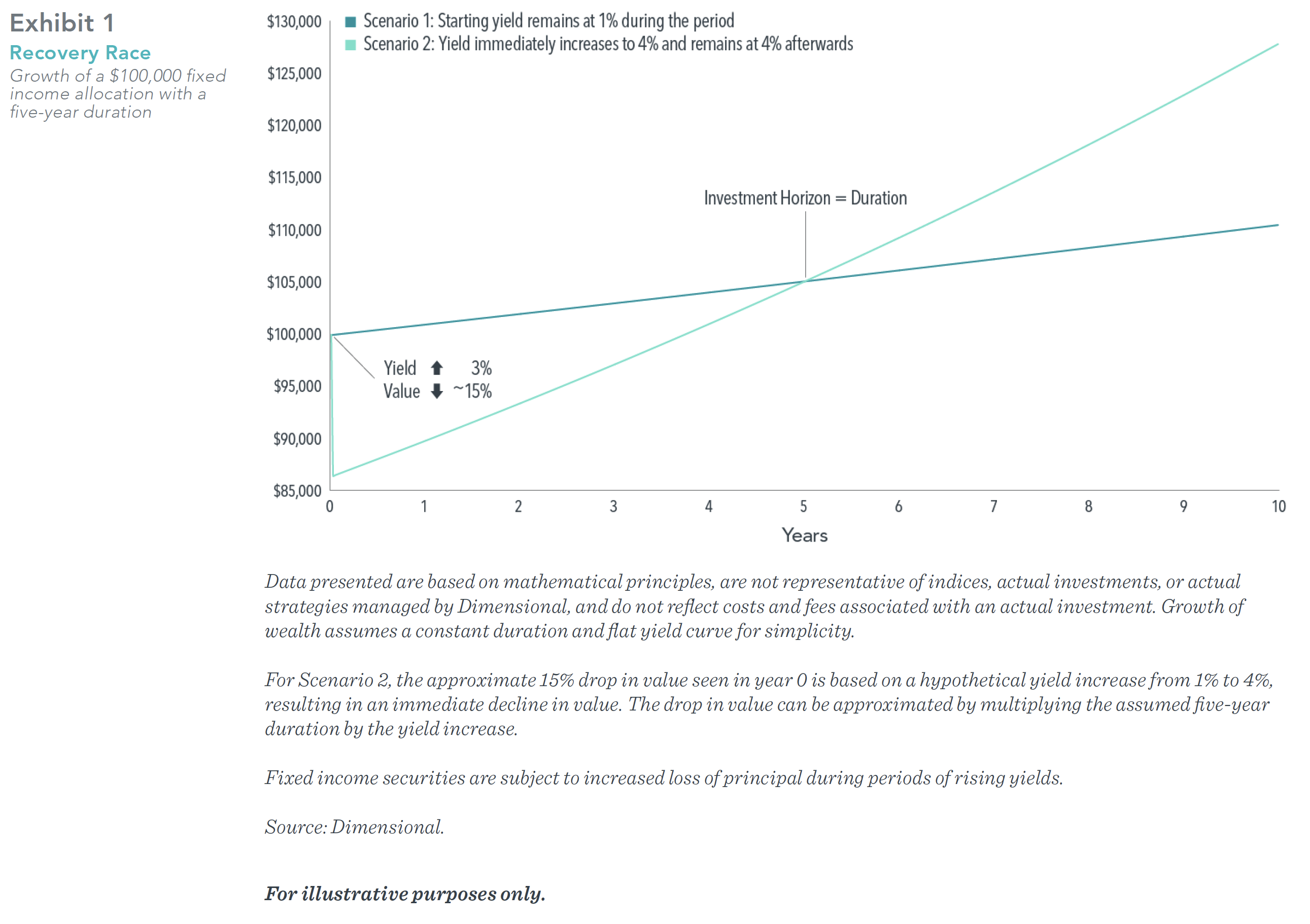Investors have likely noticed the improved opportunity set in fixed income due to higher yields. And yet some investors may be hesitant to take advantage of higher yields because of concerns about future increases in yields. Some may even be considering reducing their bond exposure after this year’s negative returns for fixed income.1 The good news? If yields do keep rising, investors seeking higher expected returns may still be better off maintaining the duration of their fixed income allocation.
Rising yields impact fixed income portfolios in several ways. On the one hand, longerduration portfolios may experience larger immediate losses from increased yields relative to shorter-duration portfolios. On the other hand, higher yields may lead to higher expected returns. Investors can think of this tradeoff as a pit stop in a Formula 1 race. The pit stop immediately causes the driver to fall back. However, fresh tires may help the driver win the race if there are enough laps left to catch the leader.
Exhibit 1 illustrates this using two scenarios for a $100,000 fixed income allocation with a five-year duration. Scenario 1 experiences a constant yield of 1% during the period. Scenario 2 is faced with a sudden spike in yield from 1% to 4% on Day 1 and sees its value immediately drop to a little over $86,000. However, the higher-yield environment accelerates Scenario 2’s recovery: With a 4% yield rather than the previous rate of 1%, Scenario 2’s portfolio value overtakes Scenario 1’s within five years—the time horizon determined by the duration of Scenario 2.
When faced with uncertainty, investors should focus on the things they can control. Research tells us that trying to outguess the market by holding on to cash, or shortening duration, with the expectation of future yield increases may not help you achieve your long-term goals.2 Markets quickly incorporate new information about higher interest rates and inflation.3 Investors who maintain appropriate asset allocations, even after increases in bond yields, may have a more rewarding investment experience in the long run.
1. The Bloomberg Global Aggregate Bond Index (hedged to USD) returned –12.1% from January 1, 2022, through September 30, 2022.
2. Doug Longo, “Bonds Deliver Positive Returns in July 2022,” Insights (blog), Dimensional Fund Advisors, August 12, 2022.
3. Wes Crill, “Light at the End of the Inflation Tunnel,” Insights (blog), Dimensional Fund Advisors, June 10, 2022; “Markets Appeared to Be Ahead of the Fed,” Insights (blog), Dimensional, June 16, 2022.
DIMENSIONAL FUND ADVISORS AND TRIAD ADVISORS ARE NOT AFFILIATED.
The information in this document is provided in good faith without any warranty and is intended for the recipient’s background information only. It does not constitute investment advice, recommendation, or an offer of any services or products for sale and is not intended to provide a sufficient basis on which to make an investment decision. It is the responsibility of any persons wishing to make a purchase to inform
themselves of and observe all applicable laws and regulations. Unauthorized copying, reproducing, duplicating, or transmitting of this document are strictly prohibited. Dimensional accepts no responsibility for loss arising from the use of the information contained herein.
“Dimensional” refers to the Dimensional separate but affiliated entities generally, rather than to one particular entity. These entities are Dimensional Fund Advisors LP, Dimensional Fund Advisors Ltd., Dimensional Ireland Limited, DFA Australia Limited, Dimensional Fund Advisors Canada ULC, Dimensional Fund Advisors Pte. Ltd, Dimensional Japan Ltd., and Dimensional Hong Kong Limited. Dimensional Hong Kong Limited is licensed by the Securities and Futures Commission to conduct Type 1 (dealing in securities) regulated activities only and does not provide asset management services.
Dimensional Fund Advisors LP is an investment advisor registered with the Securities and Exchange Commission.
RISKS
Investments involve risks. The investment return and principal value of an investment may fluctuate so that an investor’s shares, when redeemed, may be worth more or less than their original value. Past performance is not a guarantee of future results. There is no guarantee strategies will be successful.
Share this article:
Investor Risk Capacity Survey
Receive Your Risk Number
Take a 5-minute survey that covers topics such as portfolio size, top financial goals, and what you’re willing to risk for potential gains. We’ll use your responses to pinpoint your exact Risk Number to guide our decision-making process.

